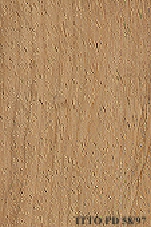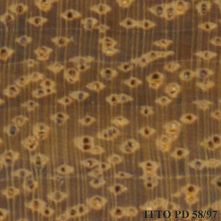
MERBAU (Intsia bijuga)
Trade Name
Merbau
Scientific Name
Intsia bijuga (Colebr.) Kuntze
Family
LEGUMINOSAE
Common Names
Ipil laut (Philippines); Ipil (Sarawak); Merbau (Indonesia); Mirabow (Sabah); Lum-paw (Thailand); Ipil (Philippines); Gonuo (Vietnam); Merbau (Netherlands); Kalabau (China); Kwila (Papua New Guinea); Komu (New Caledonia); Kwila (Australia); Merbau (United Kingdom); Hintsy (Madagascar)
Scientific Name Synonyms
Macrolobium bijugum Colebr.
Description Of The Tree
Botanical Description
It is a medium-sized to large tree up to 50 m tall. The bole is branchless for up to 20 m and up to 160 cm in diameter.
Natural Habitat
It is a lowland rain forest tree which produces one of the most valuable timbers of South East Asia. It is common in lowland forests, in transitional zones behind mangroves.
Natural Distribution
It is distributed in the Indo-Malayan region, Indonesia, Philippines, and many of the western Pacific islands as well as in Australia.
Plantations Available?
Plantations of "Merbau" are reported.
Non Timber Uses
Merbatu timber is reported to stain black in presence of iron.
Wood Identification
Anatomic Description Of Wood
Vessels per mm2 less than 6 (rare). Tangential diameter of vessel lumina 200 micras or more (large). Vestured pits. Vessel-ray pits similar to intervessel pits in size and shape. Simple perforation plates. Intervessel pits small, 7 micras or less. Axial parenchyma aliform. Axial parenchyma confluent. Axial parenchyma in narrow bands on lines up to 3 cells wide. Homogeneous rays and/or sub-homogeneous rays (all ray cells procumbent). Fibers with distinctly bordered pits.
-
 Wood Macro Photo Tangential Plane
Wood Macro Photo Tangential Plane
-
 Wood Micro Photo Of Transversal Section
Wood Micro Photo Of Transversal Section
Availability
Cites Status
Unrestricted
General Wood Description
Odor
It has the characteristic odor when fleshly cut, resembling that raw of beans, and bitter taste.
Color
The sapwood is clearly differentiated, lighter pale yellow. The heartwood varies from brownish gray through bronze to dark brown, darkening with age.
COLOR INDEX (1=Black, 7=Light yellow,white)
5
Grain
It is not always straight, occasionally interlocked.
Texture
It is coarse and homogeneous.
Luster
The sapwood has somewhat greenish luster.
Natural Durability
It is very durable, but the sapwood is vulnerable to the fungi and insect attack.
Natural durability index (1= Very high durability, 7=Vey low durability)
2
Silica Content
Silica Content: It is reported to contain 0.2% silica. Silica Value: 0.2
Resistance To Impregnation
The heartwood is very difficult to treat.
Wood Physical Properties
Basic Density or Specific Gravity (O.D. weight/vol. green) (g/cm³)
0.73
Air-dry Density (Weight and volume at 12%MC) (g/cm³)
0.83
Total shrinkage Tangential (Saturated to 0%MC) (%)
4.9
Total shrinkage Radial (Saturated to 0%MC) (%)
2.7
Drying Defects
Ease of Drying: Air seasoning is reported to be good.
Recommended Dry Kiln Schedule
UK-C; US-T3-C2
Dimensional stability ratio (Total Tangential Shrinkage %/Total Radial Shrinkage %)
1.8
Wood Chemical Properties
Wood Mechanical Properties
Bending Strength (MOR),12%MC (kgf/cm²)
1493
Stiffness (MOE) 12%MC (kgf/cm²)
167655
Compression parallel to fiber 12%MC (kgf/cm²)
785
Shear strength radial 12%MC (kgf/cm²)
183
Janka hardness (side) 12%MC (kgf)
797
Janka hardness (end grain) 12%MC (kgf)
774
Workability
Sawing
The response of this wood in sawing is fair to difficult. During sawmilling, the teeth might become covered with gums.
Rotary Veneer Cutting
It is difficult to cut or slice into veneer, even after pre-streaming, mainly due to its high density.
Sliced Veneer
It is difficult to cut or slice into veneer, even after pre-streaming, mainly due to its high density.
Blunting Effect
Wood of this species exerts a moderate blunting effect on the cutting tools.
Machining
Machining of this species is fair to difficult.
Planing
A reduction of the cutting angle to 20 degrees is advantageous in planing quarter-sawn material with interlocked grain to prevent picking-up of grain.
Turning
30
Boring
Boring is reported to be easy.
Nailing
This species is reported to have a poor nailing behavior.
Gluing
Gluing behavior is reportedly good.
Finishing
Finishing is rated as good to fair. It has to be protected from humidity until the finishing operations are completed.
Staining
Wood of this species is easy to stain.
Coatings
Painting or varnishing of this wood is easy.
Polishing
The wood stains and polishes satisfactorily, but requires considerable filling.
REFERENCED USES
End Uses Summary
EXTERIOR GENERAL, poles, rails, crossties, piers, HOUSING GENERAL, flooring, frames, steps, panelling, FURNITURE AND CABINETS, TURNING, cutlery, SPORTS, TOOLS, tool handles, agricultural tools, CONTAINERS, chemical storage, truck bodies, truck flooring, NAVAL CONSTRUCTION, port pillar, port storage, OTHER AND MUSICAL INSTRUMENTS, handicrafts, matches
Exterior General
- 1 - Tabela de resultados de ensaios fisicos e mecanicos
Poles
- 3 - Estudo dendrologico e determinacao das caracteristicas fisicas e mecanicas do genipapo (Genipa americana)
Rails
- 6 - Physical and mechanical properties of Eucalyptus deglupta Blume grown in Costa Rica
Crossties
- 8 - Maderas latinoamericas. III, Podocarpus standleyi ,Podocarpus oleifolius, Drims granadensis, Magnolia poasana y Didymopanax pittieri
Piers
- 9 - Maderas latinoamericanas. IV, Nectandra sp. Ocotea austinii, Persea sp. aff. vesticula, Persea schiedeana
General Housing
- 10 - Silica in Timbers
Flooring
- 14 - Handbook of Hardwoods
Frames
- 16 - Woods of the World
Steps
- 17 - Tree Conservation Database
Paneling
- 18 - W3TROPICOS Missouri Botanical Garden
Furniture Cabinets
- 21 - Tropical timbers of the world. Part III-Southeast Asian and Oceanian Species.
Turning
- 30 - Embassy of Honduras in Japan
Knife Handles
- 33 - Embassy of Gabon in Japan
Sports
- 38 - Annual Review and Assessment of the World Timber Situation 1998-ITTO
Tools
- 42 - Utilización Industrial de Nuevas Especies Forestales en el Perú.
Tool Handles
- 43 - Maderas de Bolivia (Características y Usos de 55 Maderas Tropicales)
Agricultural Tools
- 44 - Atlas of Peruvian Woods
Containers
- 50 - Properties of imported tropical woods
Chemical Storage
- 52 - Propiedades mecanicas y asociadas del pino insigne (Pinus radiata d.don)
Truck Body
- 53 - Timbers of the New World
Truck Flooring
- 54 - Bulletin of the Government Forest Experiment Station N.157: Identification of Tropical Woods
Shipbuilding
- 55 - Tropical Timber Atlas of Latin America
Port Pillar
- 61 - Manual de Diseño para Maderas del Grupo Andino
Port Storage
- 62 - Estudio Tecnológico de Maderas del Perú (Zona Pucallpa) Vol I
Other & Musical Instruments
- 63 - Madeiras do Brazil II
Handcraft
- 66 - Maderas latinoamericanas. VII. Caracteristicas anatomicas. propiedades fisicomecanicas, de secado, y tratabilidad de la madera juvenil de Cordia alliodora (Ruiz & Pav. Oken.)
Matches
- 71 - Proprietes physiques et mecaniques des bois tropicaux, premier supplement
Please Provide Information To View Producer Information